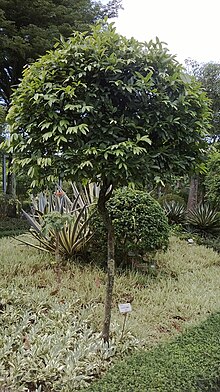Uvaria siamensis
| Uvaria siamensis | |
|---|---|

| |
| Scientific classification | |
| Kingdom: | Plantae |
| Clade: | Tracheophytes |
| Clade: | Angiosperms |
| Clade: | Magnoliids |
| Order: | Magnoliales |
| Family: | Annonaceae |
| Genus: | Uvaria |
| Species: | U. siamensis
|
| Binomial name | |
| Uvaria siamensis (Scheff.) L.L.Zhou, Y.C.F.Su & R.M.K.Saunders (2009)
| |
| Synonyms[1] | |
| |
Uvaria siamensis (locally called nom-maew) is a plant in the family Annonaceae.[1][2] Uvaria siamensis is a shrub or liana native to Myanmar, Laos, Thailand, Cambodia, Vietnam, and northern Peninsular Malaysia.[1]
It is related to the ylang-ylang. It requires little care and can even be kept in containers, blooming from spring until fall. Despite their plainness, the flowers of the genus Uvaria have a aroma that can travel very far. It is for this that Asian gardeners include it among their favorite garden plants. This plant can tolerate some shade; however, lack of sunlight adversely affects flowering.
Description[edit]
The Uvaria siamensis a perennial plant with a small trunk, and a height of 1–2 meters, darkly-coloured stalks and drooping branches. Their leaves are especially monocotyledonous, long, and sharp. A single one can bloom as group of 1–3 flowers, which are yellow-green in color, 1–2 cm large, very fragrant, and have 6 petals. The flowers bloom throughout the year.
Cultivation and culture[edit]
This tree is a good container plant. It is relatively problem-free and requires little care. Even though the flowers are inconspicuous, a single flower has a quite strong and pleasant aroma, thus the plant has a high value and is often used in Asian gardens.
The nom-maew is sometimes called the 'tree of Thailand'. It is one of the two species considered the national flower of Cambodia. It is also the provincial flower of Sisaket province, Thailand. It is very common in Cambodia, where it is often planted as a decorative tree in public parks.[3]
Properties[edit]
It is an essential ingredient in an Indonesian herbal concoction which includes, besides nom-maew, ginseng root and powdered corn. It has a pleasant taste and aroma, and claims to have a variety of benefits including: improving muscle one, expands circulation, reduces blood pressure, restores a regular heart rhythm, increases red blood cell count, reduces pain and fatigue, cleanses the body of toxic substances and stimulates intellectual activity.
References[edit]
- ^ a b c "Uvaria siamensis (Scheff.) L.L.Zhou, Y.C.F.Su & R.M.K.Saunders | Plants of the World Online | Kew Science". Plants of the World Online. Retrieved 5 June 2024.
- ^ Salae, Abdul-Wahab; Chairerk, Orapan; Sukkoet, Piyanut; Chairat, Therdsak; Prawat, Uma; Tuntiwachwuttikul, Pittaya; Chalermglin, Piya; Ruchirawat, Somsak (2017-03-01). "Antiplasmodial dimeric chalcone derivatives from the roots of Uvaria siamensis". Phytochemistry. 135: 135–143. doi:10.1016/j.phytochem.2016.12.009. ISSN 0031-9422.
- ^ "Romduol - National Flower of Cambodia". Archived from the original on 2011-07-06. Retrieved 2009-08-23.
Further reading[edit]
- Alex Butova. (ม.ป.ป.). Fragrant Plants of Annonaceae Family. เข้าถึงได้จาก Top Tropicals: http://toptropicals.com/html/toptropicals/articles/trees/annonaceae_fragrant.htm
- นันทวัน บุณยะประภัศร, อรนุช โชคชัยเจริญพร, และ มหาวิทยาลัยมหิดล คณะเภสัชศาสตร์. (2541). สมุนไพรไม้พิ้นบ้าน เล่ม2. กรุงเทพ: กรุงเทพฯ : คณะเภสัชศาสตร์ มหาวิทยาลัยมหิดล.
